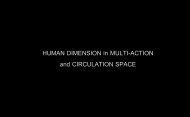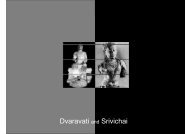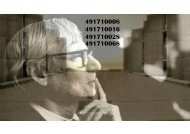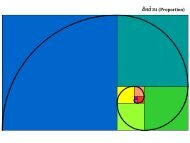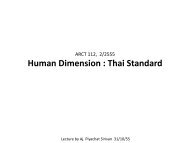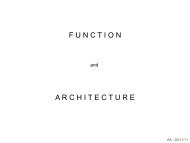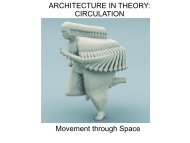IDENTITY INTIMACY AND DOMICILE Notes on the phenomenology of home
Notes on the phenomenology of home - Faculty of Architecture ...
Notes on the phenomenology of home - Faculty of Architecture ...
You also want an ePaper? Increase the reach of your titles
YUMPU automatically turns print PDFs into web optimized ePapers that Google loves.
JUHANI PALLASMAA: <str<strong>on</strong>g>IDENTITY</str<strong>on</strong>g>, <str<strong>on</strong>g>INTIMACY</str<strong>on</strong>g> <str<strong>on</strong>g>AND</str<strong>on</strong>g> <str<strong>on</strong>g>DOMICILE</str<strong>on</strong>g> - <str<strong>on</strong>g>Notes</str<strong>on</strong>g> <strong>on</strong> <strong>the</strong> <strong>phenomenology</strong> <strong>of</strong> <strong>home</strong>Before I reached high-school age, my family moved several times due tomy fa<strong>the</strong>r's job and, c<strong>on</strong>sequently, I lived in seven different houses duringmy childhood. In additi<strong>on</strong>, I spent my childhood summers and most <strong>of</strong> <strong>the</strong>war in my farmer grandfa<strong>the</strong>r's house. Regardless <strong>of</strong> having lived in eighthouses, I have <strong>on</strong>ly had <strong>on</strong>e experiential <strong>home</strong> in my childhood; myexperiential <strong>home</strong> seems to have travelled with me and been c<strong>on</strong>stantlytransformed to new physical shapes as we moved.I cannot recall <strong>the</strong> exact architectural shape or layout <strong>of</strong> any <strong>of</strong> <strong>the</strong> eighthouses. But I do recall vividly <strong>the</strong> sense <strong>of</strong> <strong>home</strong>, <strong>the</strong> feeling <strong>of</strong> returning<strong>home</strong> from a skiing trip in <strong>the</strong> darkness <strong>of</strong> a cold winter evening. Theexperienee <strong>of</strong> <strong>home</strong> is never str<strong>on</strong>ger than when seeing <strong>the</strong> windows <strong>of</strong><strong>the</strong> house lit in <strong>the</strong> dark winter landscape and sensing <strong>the</strong> invitati<strong>on</strong> <strong>of</strong>warmth warming your frozen limbs. 'Light in <strong>the</strong> window <strong>of</strong> <strong>the</strong> <strong>home</strong> is awaiting light' 8, as Bachelard has observed. The <strong>home</strong> has a soul. I cannotrecall <strong>the</strong> shape <strong>of</strong> <strong>the</strong> fr<strong>on</strong>t door <strong>of</strong> my grandfa<strong>the</strong>r's house ei<strong>the</strong>r, but Ican still sense <strong>the</strong> warmth and odour <strong>of</strong> air flowing against my face as Iopen <strong>the</strong> door.In an essay entitled 'The Geometry <strong>of</strong> Feeling' (1985) 9, I have dealt with<strong>the</strong> properties <strong>of</strong> lived space as compared to comm<strong>on</strong> noti<strong>on</strong>s <strong>of</strong>architecture. It seems to me that emoti<strong>on</strong>s deriving from built form andspace arise from distinct c<strong>on</strong>fr<strong>on</strong>tati<strong>on</strong>s between man and space. Theemoti<strong>on</strong>al impact is related to an act, not an object or a visual or figuralelement. The <strong>phenomenology</strong> <strong>of</strong> arehitecture is founded <strong>on</strong> verbs ra<strong>the</strong>rthan nouns. The approaching <strong>of</strong> <strong>the</strong> house, not <strong>the</strong> facade, <strong>the</strong> act <strong>of</strong>entering, not <strong>the</strong> door; <strong>the</strong> act <strong>of</strong> looking out <strong>of</strong> <strong>the</strong> window, not <strong>the</strong>window itself; or <strong>the</strong> act <strong>of</strong> ga<strong>the</strong>ring around ra<strong>the</strong>r than <strong>the</strong> hearth or <strong>the</strong>table as such seem to trigger our str<strong>on</strong>gest emoti<strong>on</strong>s.Nostalgia <strong>of</strong> <strong>home</strong>I also remember <strong>the</strong> sadness and secret threat <strong>of</strong> leaving <strong>the</strong> <strong>home</strong> as wemoved to ano<strong>the</strong>r town. The greatest tragedy was <strong>the</strong> fear <strong>of</strong> facing anunknown future and losing <strong>on</strong>e's childhood friends.It is clear that <strong>the</strong> experience <strong>of</strong> <strong>home</strong> c<strong>on</strong>sists <strong>of</strong> and integrates anincredible array <strong>of</strong> mental dimensi<strong>on</strong>s from that <strong>of</strong> nati<strong>on</strong>ality and beingsubject to a specific culture to those <strong>of</strong> unc<strong>on</strong>scious desires and fears. Now<strong>on</strong>der sociologists have found out that <strong>the</strong> sorrow for a lost <strong>home</strong> am<strong>on</strong>gslum residents is very similar to <strong>the</strong> mourning a lost relative.There is a strange melancholy in an aband<strong>on</strong>ed <strong>home</strong> or a demolishedapartment house that reveals traces and scars <strong>of</strong> intimate lives to <strong>the</strong>http://www2.uiah.fi/esittely/historia/e_ident.htm (8 <strong>of</strong> 23)22/10/2550 16:34:02



